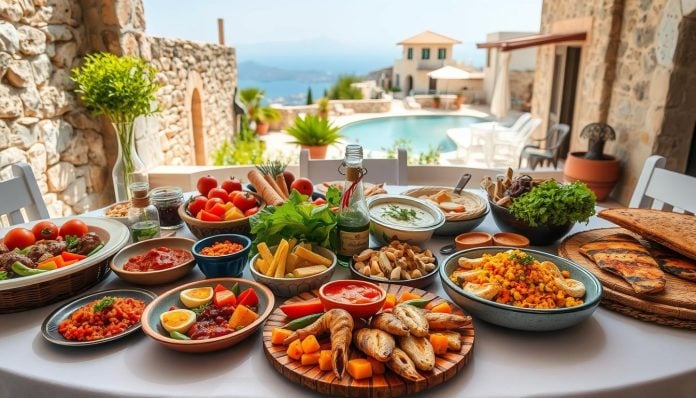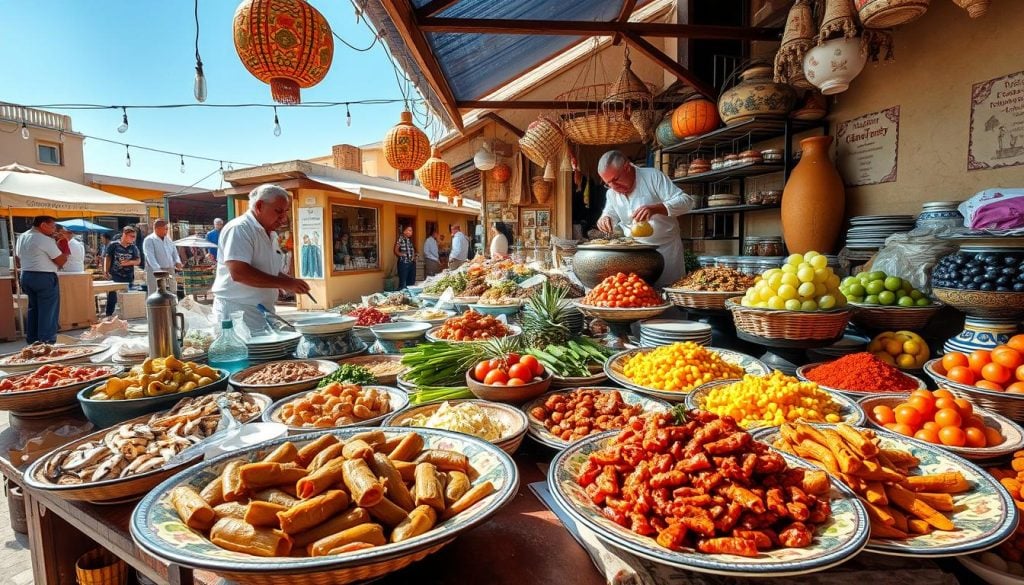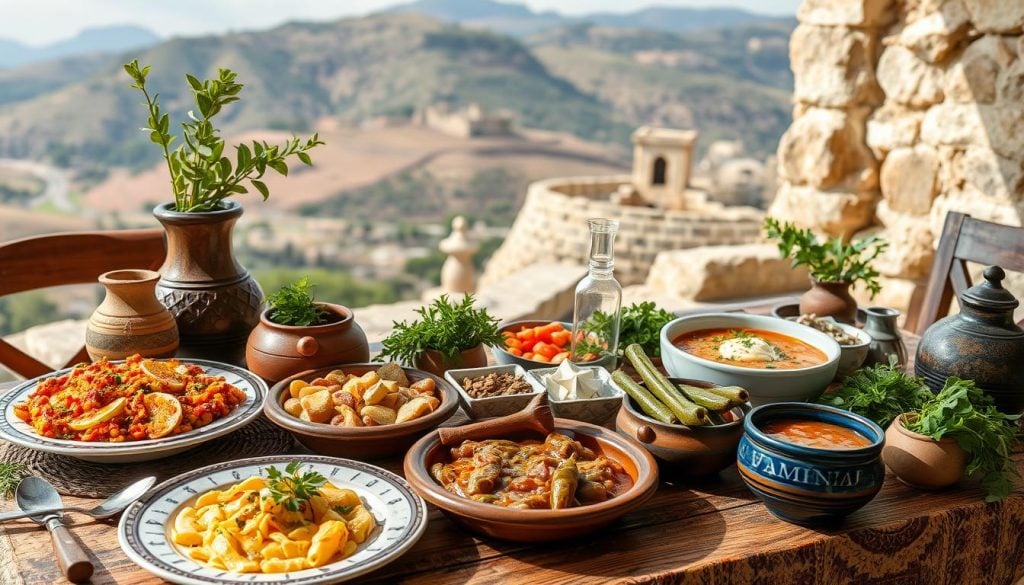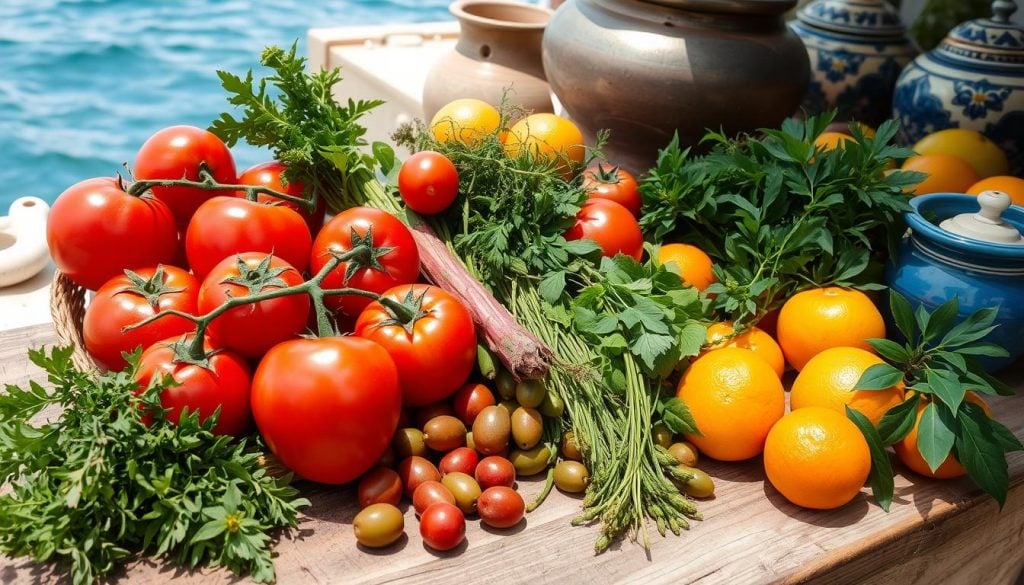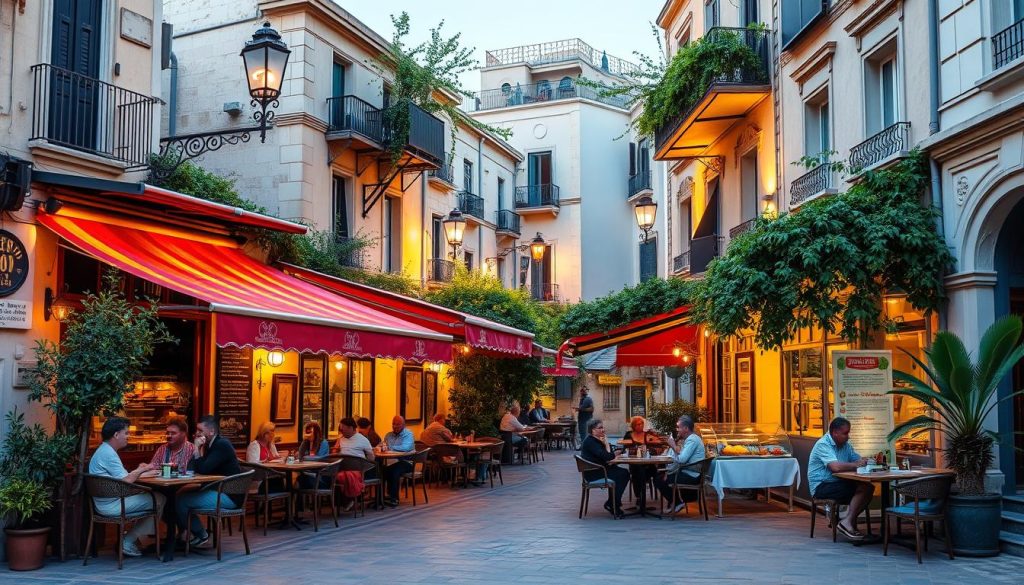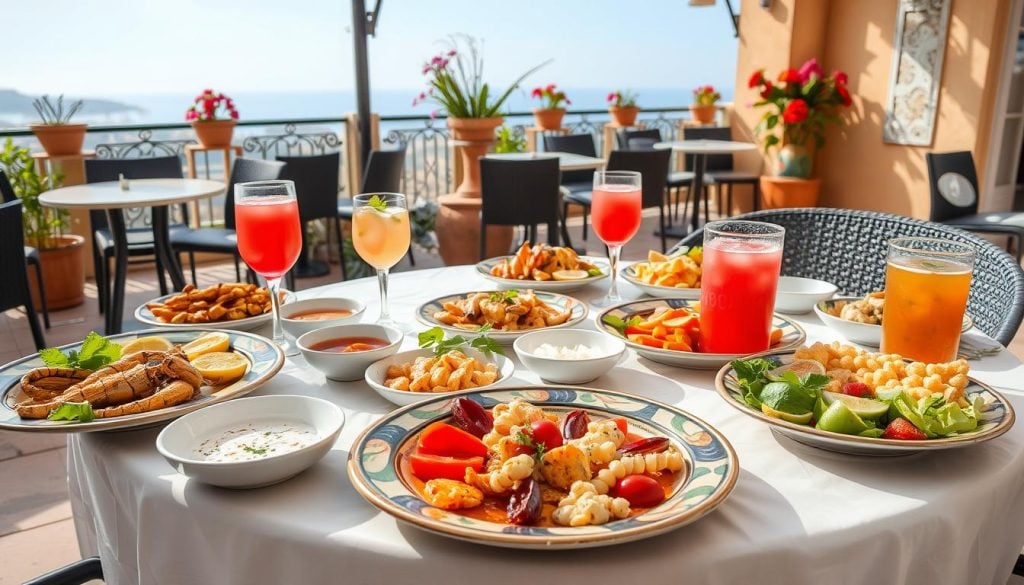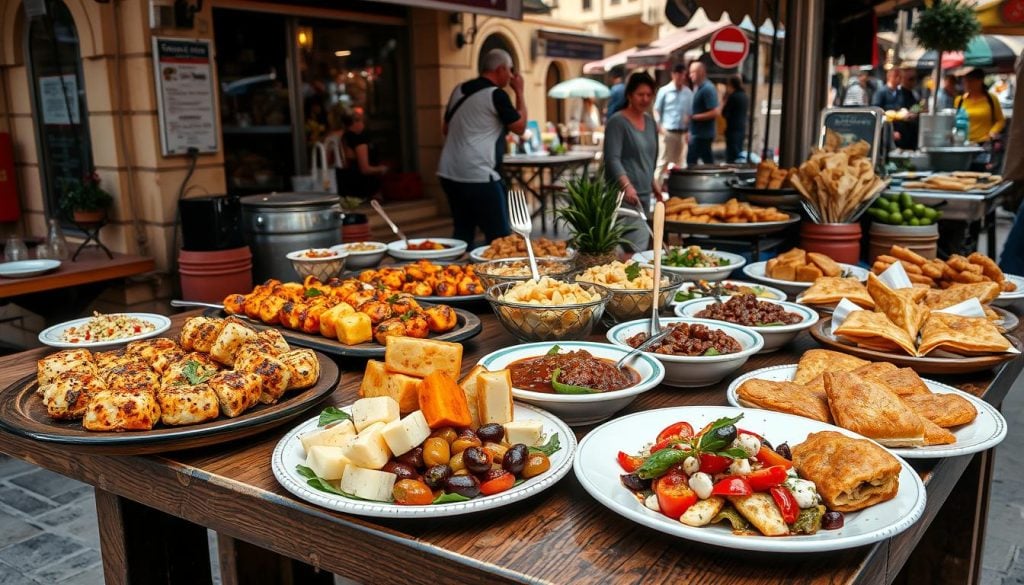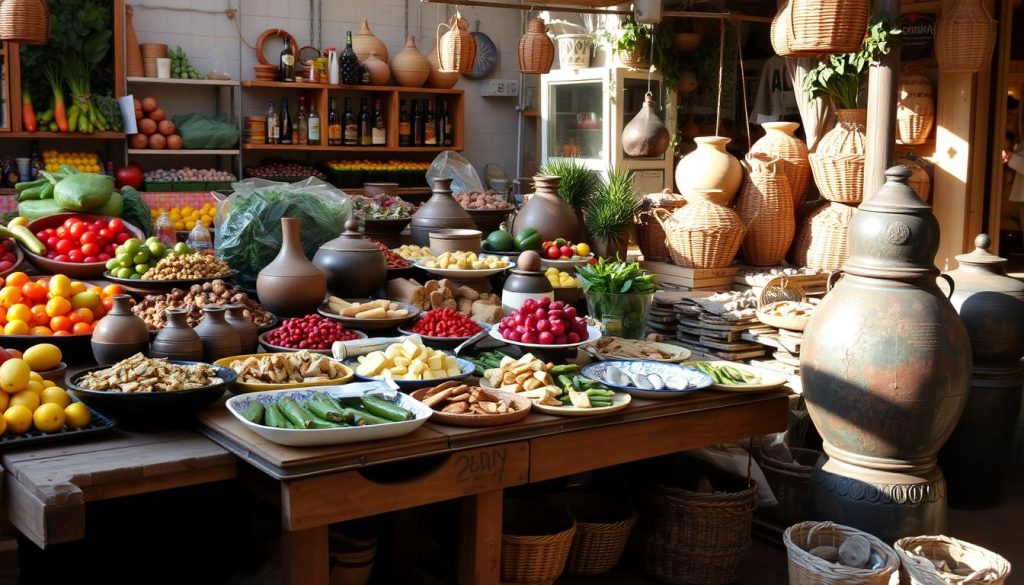Ever thought about how food can define a place? In Famagusta, it’s as colorful as the Mediterranean itself. The mix of Greek and Turkish flavors in Famagusta’s food tells stories of heritage and community. It’s a taste of Cypriot warmth.
Join us on a food journey through Famagusta. You’ll discover delicious traditions and flavors. They show what makes Famagusta’s food so special, leaving you wanting more.
Exploring the Culinary Landscape of Famagusta
Famagusta’s food scene is a mix of old and new. You can find cozy taverns and modern restaurants. These places show off the Famagusta food culture with dishes that tell the island’s story.
Food festivals in the city celebrate local food. They bring people together to try traditional dishes. It’s a great way to dive into the local culture and taste many flavors.
Looking for the best restaurants in Famagusta? Or just a place for a quick bite? There’s something for everyone. Here are some top spots to check out:
| Restaurant Name | Cuisine Style | Notable Dishes | Ambiance |
|---|---|---|---|
| Santa Maria | Traditional Cypriot | Meze platter, Grilled halloumi | Rustic, family-friendly |
| Salty Bay | Seafood | Fresh catch of the day, Octopus salad | Seaside, relaxed |
| Vasiliki | Modern Mediterranean | Lamb chops, Stuffed peppers | Chic, upscale |
| Agora | Casual Dining | Souvlaki, Village salad | Casual, lively |
Trying out these places will give you a deeper love for Famagusta’s food. Each spot offers a special taste experience. Together, they make up the rich food culture of Famagusta.
What is the food like in Famagusta?
Famagusta’s food is a mix of flavors that show its history and location. This mix makes meals vibrant and hearty, appealing to many. Exploring Famagusta’s food, you’ll see a focus on fresh ingredients and old ways of cooking.
Characteristics of Famagusta’s Cuisine
Famagusta’s food is all about freshness and quality. Local dishes often use seasonal fruits, veggies, and herbs. Olive oil is key, adding richness to many dishes.
Enjoying meals together is big here, especially meze. Meze is a tradition of small, shared plates. It’s not just about the food but also about sharing with others.
Influences of Mediterranean Ingredients
Mediterranean ingredients shape Famagusta’s food. Local dishes use spices and flavors that remind you of the sea. You’ll find fresh seafood, grains, and legumes, often with herbs like oregano and thyme.
These ingredients come together beautifully. They make dining an experience that honors tradition and the local area.
Traditional Cypriot Dishes You Must Try
Exploring Famagusta’s food scene means trying its traditional dishes. A must-try is meze, a mix of small dishes. It’s great for sharing with friends and family, offering a taste of many flavors.
Culinary Essentials: Meze
Meze is a key part of local culture. It includes dips, cheeses, grilled meats, and salads. This way of eating brings people together, as everyone shares from the platter.
- Hummus
- Tzatziki
- Stuffed vine leaves
- Fried halloumi
Every bite shows the quality of Famagusta’s traditional food.
Signature Sweets: Baklava and Lokma
Don’t forget to try the desserts with a rich history. Baklava is a pastry filled with nuts and honey. Lokma is deep-fried dough balls in syrup, a sweet treat to end your meal.
Local Ingredients that Define Famagusta’s Cuisine
Famagusta’s food scene is all about fresh, local ingredients. These elements blend together to create a unique flavor profile. This is what makes Famagusta’s dishes so special.
Fresh Produce and Herbs
In Famagusta, you’ll find a wide variety of fresh produce. These include:
- Vine-ripened tomatoes
- Fragrant mint
- Crunchy cucumbers
- Sweet bell peppers
- Robust eggplants
These ingredients add depth to local recipes. They make every meal a celebration of the area’s rich farming history.
Quality of Local Seafood and Meats
Famagusta’s close proximity to the Mediterranean Sea makes it a seafood paradise. Locals enjoy a variety of fresh catches, including:
- Sardines
- Octopus
- Sea bass
- Calamari
These seafood options add to the richness of Famagusta’s cuisine. Locally raised meats, such as:
- Lamb
- Chicken
- Beef
| Ingredient Category | Examples | Typical Dishes |
|---|---|---|
| Fresh Produce | Tomatoes, Mint, Cucumbers | Salads, Dips |
| Seafood | Sardines, Octopus | Grilled Fish, Seafood Platter |
| Meats | Lamb, Chicken | Shish Kebabs, Stews |
The variety of local ingredients makes Famagusta’s cuisine more than just food. It’s a reflection of the region’s heart and soul. Every meal is an invitation to taste the essence of Famagusta.
The Art of Meze in Famagusta
Meze is at the heart of Famagusta’s traditional cuisine. It invites diners to enjoy a variety of flavors together. This tradition offers small dishes that encourage sharing and interaction.
What is Meze?
Meze is a series of small plates served as appetizers. It’s perfect for trying different local dishes in Famagusta. This style of dining reflects the region’s culture, where meals are social events.
You can expect to find dips, olives, fresh salads, and grilled meats and savory pastries. It’s a way to experience the local flavors.
Popular Meze Dishes to Sample
Some dishes in meze are especially popular for their unique flavors and local ingredients. Here are a few:
- Halloumi Cheese: This beloved cheese is grilled to perfection, offering a delightful texture and flavor.
- Grilled Octopus: A coastal favorite, it’s prepared to highlight the quality of local seafood.
- Tarator: A refreshing dip made from tahini and garlic, great with fresh bread.
- Stuffed Vine Leaves: Tender leaves filled with rice and spices, showing the region’s love for fresh herbs.
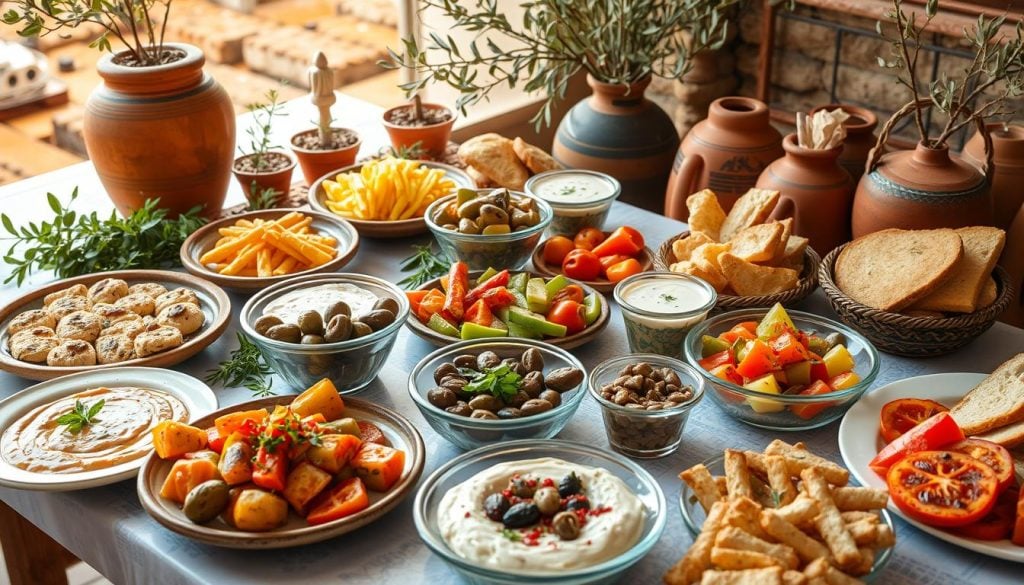
These dishes give you a glimpse into the vibrant world of meze. By trying them, you dive into the rich flavors and cultural significance of Famagusta’s local cuisine.
| Meze Dish | Description | Main Ingredients |
|---|---|---|
| Halloumi Cheese | Grilled cheese with a unique texture | Halloumi |
| Grilled Octopus | Tender and flavorful seafood dish | Octopus, Olive Oil |
| Tarator | Creamy tahini dip | Tahini, Garlic, Lemon |
| Stuffed Vine Leaves | Herb-filled wrap | Vine Leaves, Rice, Spices |
Must-Try Restaurants in Famagusta
Famagusta is a treasure trove of dining spots, each offering a unique taste of the local food culture. You’ll find cozy family-run places and lively taverns. Here are some top picks for experiencing the authentic flavors of this vibrant city.
Recommended Dining Spots for Authentic Cuisine
Looking for the best places to eat in Famagusta? Check out these standout spots:
- François: Known for its wide menu of traditional Cypriot dishes, this restaurant offers a lively atmosphere that makes your meal special.
- Victoria: A family-friendly spot, Victoria serves a variety of local favorites. It’s known for its friendly service and cozy vibe, loved by both locals and tourists.
- Amore: Amore focuses on using fresh ingredients to create new twists on Cypriot dishes. It’s a place where you’ll have a memorable meal in a friendly setting.
Unique Dining Experiences in Local Taverns
Exploring Famagusta’s food culture means visiting local taverns. Here’s what awaits you:
- Lively Music and Dance: Taverns often feature traditional music and dance, making the atmosphere lively and fun.
- Sharing Plates: The tradition of sharing meze encourages socializing. It lets you try different flavors with your loved ones.
- Authentic Settings: Many taverns keep their historical decor, giving you a taste of the area’s rich history while you enjoy your meal.
Famagusta’s Food Culture and Traditions
In Famagusta, sharing meals is key to building strong bonds. It’s not just about eating; it’s about coming together. This makes every meal a special time for family and friends.
Importance of Sharing Meals
Dining together in Famagusta is a tradition that starts conversations. Food is at the heart of many rituals and gatherings. It’s a way to enjoy unique tastes and hear the stories behind each dish.
This practice strengthens connections, making meals a big part of the culture.
Cultural Celebrations and Food Festivals
Famagusta celebrates with many food festivals throughout the year. These events highlight local ingredients and bring people together. You’ll enjoy traditional music, dancing, and delicious local dishes.
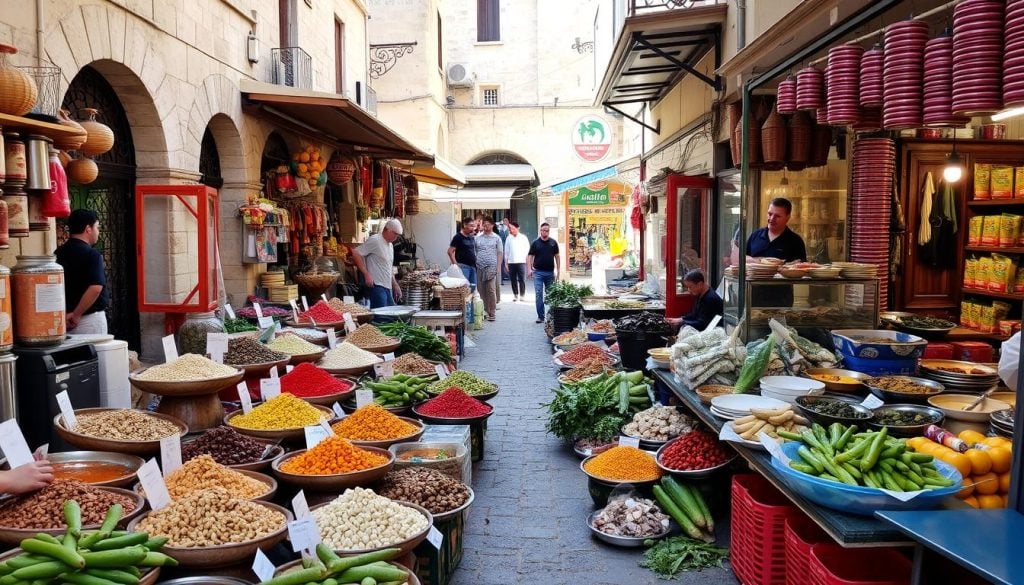
Exploring Famagusta’s food culture reveals the community’s values and traditions. Food celebrations show that meals are more than flavors. They are a way to express love and identity.
Refreshing Local Drinks to Accompany Your Meal
Enjoying your meal in Famagusta means trying local drinks that go great with traditional dishes. These drinks show off the area’s rich food history. They mix unique tastes that match the Mediterranean cuisine of Famagusta.
Traditional Cypriot Beverages
Airani is a top pick among Cypriot drinks. It’s a cool yogurt and mint drink that pairs well with strong Famagusta flavors. Zivania, a strong spirit with deep history, is also a favorite for those wanting real local tastes.
Signature Wines and Sweet Drinks
Famagusta is famous for its wines, loved all over the world. Commandaria, a sweet dessert wine, is a beloved Cypriot choice. It goes great with both savory and sweet foods. This drink not only makes your meal better but also shows off Famagusta’s winemaking pride.
| Beverage | Description | Pairing Suggestions |
|---|---|---|
| Airani | A refreshing yogurt-based drink with mint. | Meze, grilled meats |
| Zivania | A strong distilled spirit, often served as an aperitif. | Traditional Cypriot appetizers |
| Commandaria | A sweet, dessert wine with rich historical roots. | Baklava, roasted nuts |
Exploring Street Food in Famagusta
Street food in Famagusta is an unforgettable experience. It lets you dive into local flavors. The streets buzz with food vendors offering a variety of dishes.
Savory wraps filled with souvlaki are a popular choice. They are grilled to perfection and served with fresh vegetables. Another must-try is sheftalia, a traditional sausage made from minced pork with aromatic spices.
These dishes show the essence of local culinary traditions. You’ll also find fresh salads, pita bread, and refreshing dips like tzatziki. These add to your tasting experience.
As you explore, look out for bustling markets and food stalls. Here, you can enjoy these local dishes. The casual atmosphere is perfect for enjoying a meal and taking in the street culture.
- Souvlaki wraps
- Sheftalia sausages
- Various fresh salads
- Pita bread
- Tzatziki dip
Exploring street food is key to understanding Famagusta’s culinary scene. It offers new experiences and connects you with the local culture. Dive into the enticing flavors available throughout the city.
Incorporating Famagusta’s Cuisine into Your Cooking
Bringing Famagusta’s food culture into your kitchen is fun. Essential ingredients are key to capturing its authentic flavors. Spices, local herbs, and high-quality olive oil are crucial for true Cypriot taste.
Essential Ingredients for Authentic Recipes
The heart of authentic Famagusta dishes is a few key ingredients:
- Olive oil: A primary fat used for cooking and dressing dishes.
- Fresh herbs: Parsley, dill, and mint are commonly used for their vibrant flavors.
- Spices: Sumac and coriander add depth to traditional recipes.
- Citrus: Lemons and oranges enhance the freshness of many dishes.
- Locally sourced vegetables: Eggplants, zucchini, and tomatoes are staples in many meals.
Popular Cypriot Recipes to Try at Home
Emulating the charm of Famagusta’s restaurants is possible with a few popular recipes:
- Meze: A variety of small dishes that showcase the diversity of Famagusta’s food culture.
- Baklava: A sweet pastry made with layers of filo, nuts, and honey that is loved across the region.
- Stifado: A rich meat stew flavored with wine and cinnamon, perfect for cozy family dinners.
- Seftali Kebab: Juicy kebabs made with spiced minced meat wrapped in caul fat, a true delicacy.
- Halloumi: Grilled cheese that highlights the quality of local dairy and pairs well with various dishes.
Culinary Events and Food Festivals in Famagusta
Famagusta is a lively place where food festivals are a big deal all year. These events celebrate the city’s rich food traditions. They let you try many special dishes and meet local chefs and artisans.
Experience the Vibrancy of Local Food Festivals
Local food festivals in Famagusta are a treat for food lovers. They are filled with excitement, with lots of tasty food to try. You can watch cooking demos and learn about the flavors and stories behind each dish.
Signature Dishes at Culinary Events
At these events, you’ll find dishes that show off Famagusta’s food culture. Some must-try dishes include:
- Traditional Meze: A mix of small plates with local flavors and ingredients.
- Pide: A Turkish-style flatbread with different fillings, loved in the area.
- Souvla: Grilled meats that are a big hit at local gatherings.
Going to food festivals in Famagusta is a feast for your taste buds. It also helps you learn about Cypriot food heritage. This experience lets you connect with the community and enjoy the area’s food diversity.
Historical Influences on Famagusta’s Cuisine
Famagusta’s food culture is a mix of many civilizations. Each brought its own ingredients, cooking ways, and tastes. This mix has made the food scene in Famagusta rich and varied.
The Journey of Cypriot Food Traditions
The ancient Greeks and Romans started the food journey in Famagusta. They laid the base for today’s dishes. The Ottomans then added spices and new cooking ways, making local food even more interesting.
Italian influence brought pasta and tomato dishes. The British added desserts and teas. This mix of traditions has created a unique food culture in Famagusta.
Ingredients like olive oil, fresh veggies, and grains are still key. But the recipes have changed, showing a history of cultural sharing.
| Historical Influence | Contributions to Cuisine |
|---|---|
| Ancient Greeks | Foundation of Cypriot flavors, use of herbs and olive oil |
| Ottomans | Introduction of spices, kebabs, and meze |
| Italians | Pasta and tomato-based dishes, rich flavors |
| British | Teas, desserts, and popularization of breakfast dishes |
Conclusion
Exploring Famagusta’s cuisine is a journey into a world of flavors and traditions. You’ll experience the lively meze and the enticing smells from street vendors. This mix of cultures and histories reflects the heart of Famagusta.
Trying the local dishes lets you enjoy more than just food. It connects you with the city’s warmth and hospitality. Every bite tells a story, linking you to Famagusta’s rich past and lively present.
Don’t miss out on the culinary adventures waiting for you. From cozy taverns to new dishes made with local ingredients, Famagusta’s food culture will impress you. It will leave a lasting mark on your taste buds and memories.

































